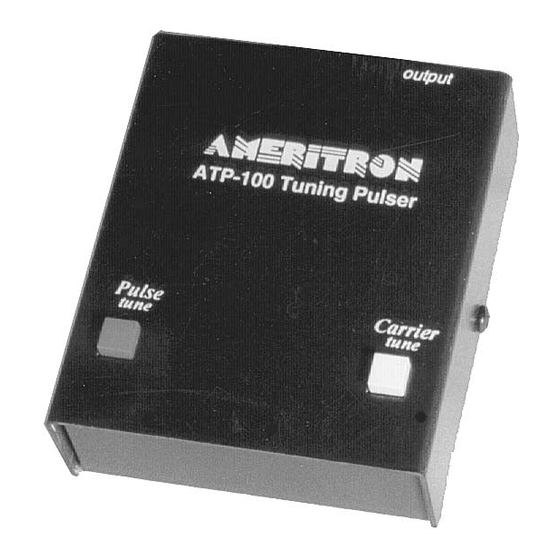AMERITRON ATP-100 Manuale di istruzioni - Pagina 8
Sfoglia online o scarica il pdf Manuale di istruzioni per Amplificatore AMERITRON ATP-100. AMERITRON ATP-100 8. Tuning pulser

ATP-100 Instruction Manual
Tuning Pulser
APPENDIX
Testing QSK Systems
The Ameritron ATP-100 Tuning Pulser can be used to evaluate QSK systems.
In one test configuration, a continuous signal source is loosely coupled to the
dummy load. The receiver is tuned to this signal source, and the Ameritron ATP-
100 Tuning Pulser controls are adjusted until the test signal is clearly audible.
The maximum QSK receive speed is found by measuring the PULSE RATE, and
multiplying the PULSE RATE by 2.4. The DUTY CYCLE should be set for
normal sounding CW dots during this test, or a 1:1 ratio.
The transmission waveshape can be checked by looking at the RF output on a
scope, with the scope triggered or synchronized to the keying line signal. A
normal CW signal has a smooth rise and fall time of about one millisecond, with
no overshoot or undershoot. Switching from manual operation to full QSK
should not disturb the keying waveform, or change the on and off time period.
Testing Wattmeters
Wattmeters can be tested by measuring the single tone power with a barefoot
exciter running off of a regulated supply, and adjusting an oscilloscope to read
near full screen with that carrier. By activating the ATP-100 with the PULSE
RATE set approximately mid-range, and adjusting the DUTY CYCLE control
until the full peak envelope voltage is just displayed on the scope, the meter can
be evaluated. A good peak reading meter should indicate the same amount of
peak power with the ATP-100 pulsing the carrier as it indicates with a
continuous carrier, as long as the maximum scope deflection remains the same.
RFI and TVI Troubleshooting
The Ameritron ATP-100 Tuning Pulser can be used to activate the transmitter
with a pulsed signal of full peak power, without undue equipment heating. This
will allow you to move to the location of the device being interfered with, while
safely operating the transmitter at high power.
You can add filters, grounds, and move cables on the device being interfered
with without fear of overheating your transmitter. The short duty cycle also
reduces interference to other amateur operators.
Be sure to have a licensed operator attending your station, and to conform to all
FCC rules regarding CW emissions.
8
